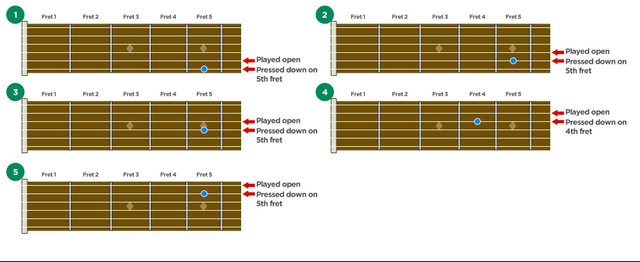A Tutorial On How To Tune A Guitar By Ear And Feeling
The art of tuning a guitar by ear is somewhat lost in our digital era we have found ourselves in. These days, there are a number of different devices available to perfectly tune your instrument. Digital tuners come in many different forms. They can be bought as separate compact devices or you can select to use an acoustic/electric guitar that has a built-in tuner. You also get effects pedals that come standard with a tuner and you can even download mobile apps to tune your guitar. While these tuners are convenient to use, however, this does not mean that guitarists shouldn't develop the skill to tune their guitars by ear. This is why I have decided to write this article. So, to all the "newbie" guitarists out there, and perhaps even seasoned players that have not picked up the skill of how to tune a guitar by ear as yet, please take the time to read this step-for-step guide in which I'll explain how to tune your guitar by ear as well as by feeling.

1. Finding The Right Pitch
To start, you will need a pitch to begin with. This means that at least one of the strings (usually the 6th string - which is the thickest string) needs to be in tune. This is not very important if you're playing by yourself or tuning two or more guitars to the pitch, but just be careful that you don't tune your strings too tight as they could possibly snap. Also, if your strings are too loose, they will vibrate on the fret-bars.
For the purpose of this guide, we will be tuning the guitar to standard E tuning.
** Quick tip - use one of your favourite songs to get the pitch of an open E 6th string. A good suggestion is to listen to the song Nothing Else Matters by Metallica, since the song starts on this note. Or you could simply search for a "standard e tuning guitar" video on Youtube to find the right pitch for one string and tune the rest of your strings myself from there.
2. Tuning Your Strings By Ear
- Play the 5th fret on the 6th string and shortly after the open 5th string. Let the two strings ring and listen carefully to the difference in the pitch.
- Now tune the 5th string until the pitch matches that of the 6th string played on the 5th fret. Keep tuning the 5th string until you can hardly hear any difference in pitch between the two strings. The reason you are doing this is because the 5th string should be tuned to the note A and the 6th string played on the 5th fret is the note A. Therefor you are actually matching notes.
It's that easy and the best thing is you simply repeat this for the rest of the strings with only one exception, to tune the second string you have to play the 3rd string on the 4th fret instead.
Take a look at the below illustrations for guidance:

3. Tuning Your Strings By Feeling
This is quite the exciting part! When you let the notes ring together and they are not entirely on the same pitch you can actually hear the sound making waves, if you listen very carefully, that is. If the pitch of the two notes are very far off, it will be difficult to hear the waves. The closer together the pitch gets, the further apart the waves are until you can you can no longer hear them. That is when the two notes are perfectly in tune with each other. So you get a sort of vibrating sound when the pitch is far off which turns into a "wha wha wha" sound as it gets closer and a "whoooaaaaaaoooohhh whoooaaaaaaoooohhh" sound as it gets even closer until all you can hear is "whaaaaaaaaaaaaaaaaaaaa" infinitely.
If you are asking yourself what this has to do with feeling,well, these waves give off vibrations which can be felt in the body of the guitar. When feeling these waves in the vibrations you simply follow the same principal as above: tune the strings until the vibrations are constant and not in waves. If you play on an electric guitar and you have access to a distortion effect, go ahead and switch that on when tuning, because you can feel the vibration waves even better then as the distortion amplifies the vibrations.
I hope this post will help you to develop the impressive skill of tuning a guitar without the use of tuning devices. It's always good to know how to tune "the old-school way"!
Much love - @sweetpea

Thank you @sweetpea. This just reminds me that I need to get back on my guitar and play!
If you would like to support the educational community by delegating to @steemiteducation, please click on any of the following links. This will ensure that more teachers are supported on a daily basis.
100SP 200SP 300SP 400SP 500SP 750SP 1000SP 2000SP 3000SP 4000SP 5000SP 10,000SP 25,000SP
Congratulations @sweetpea! You have completed the following achievement on the Steem blockchain and have been rewarded with new badge(s) :
Click on the badge to view your Board of Honor.
If you no longer want to receive notifications, reply to this comment with the word
STOPDo not miss the last post from @steemitboard: